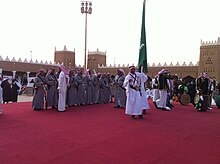Ardah
You can help expand this article with text translated from the corresponding article in Arabic. Click [show] for important translation instructions.
|
You can help expand this article with text translated from the corresponding article in Simple English. Click [show] for important translation instructions.
|

Ardah (
Originally, the "ardah" was performed only by males of tribes of the Arabian Peninsula before going to war, but nowadays it is done at celebrations, weddings, and national and cultural events by males of all tribes, such as the Jenadriyah festival. There currently exists various types of ardah across the Arabian Peninsula.[1]
It was inscribed on UNESCO's Intangible Cultural Heritage of Humanity in 2015 as Alardah Alnajdiyah.[2]
Variations
| Alardah Alnajdiyah | |
|---|---|
 Ardah at Jenadriyah | |
| Country | Saudi Arabia |
| Domains | dance, drumming and poetry. |
| Reference | 01196 |
| Inscription history | |
| Inscription | 2015 |
| List | Representative |
 | |
The term 'ardah' (عَرْضَة) is thought to derive from the Arabic verb ard (عَرَضَ) meaning 'to show' or 'to parade'. It was so named because its purpose was to publicly display the fighting strength of a tribe and boost morale before an armed engagement.[1] Although there are regional variations of the particular rendition of ardah, the purpose it serves is nearly identical throughout the Arabian Peninsula.[1]
Saudi ardah
Najdi ardah is the most common variant of ardah in
See also
References
- ^ ISBN 978-0415888721.
- ^ "UNESCO - Alardah Alnajdiyah, dance, drumming and poetry in Saudi Arabia". ich.unesco.org. Retrieved 2019-02-07.
- ISBN 978-0415888721.
